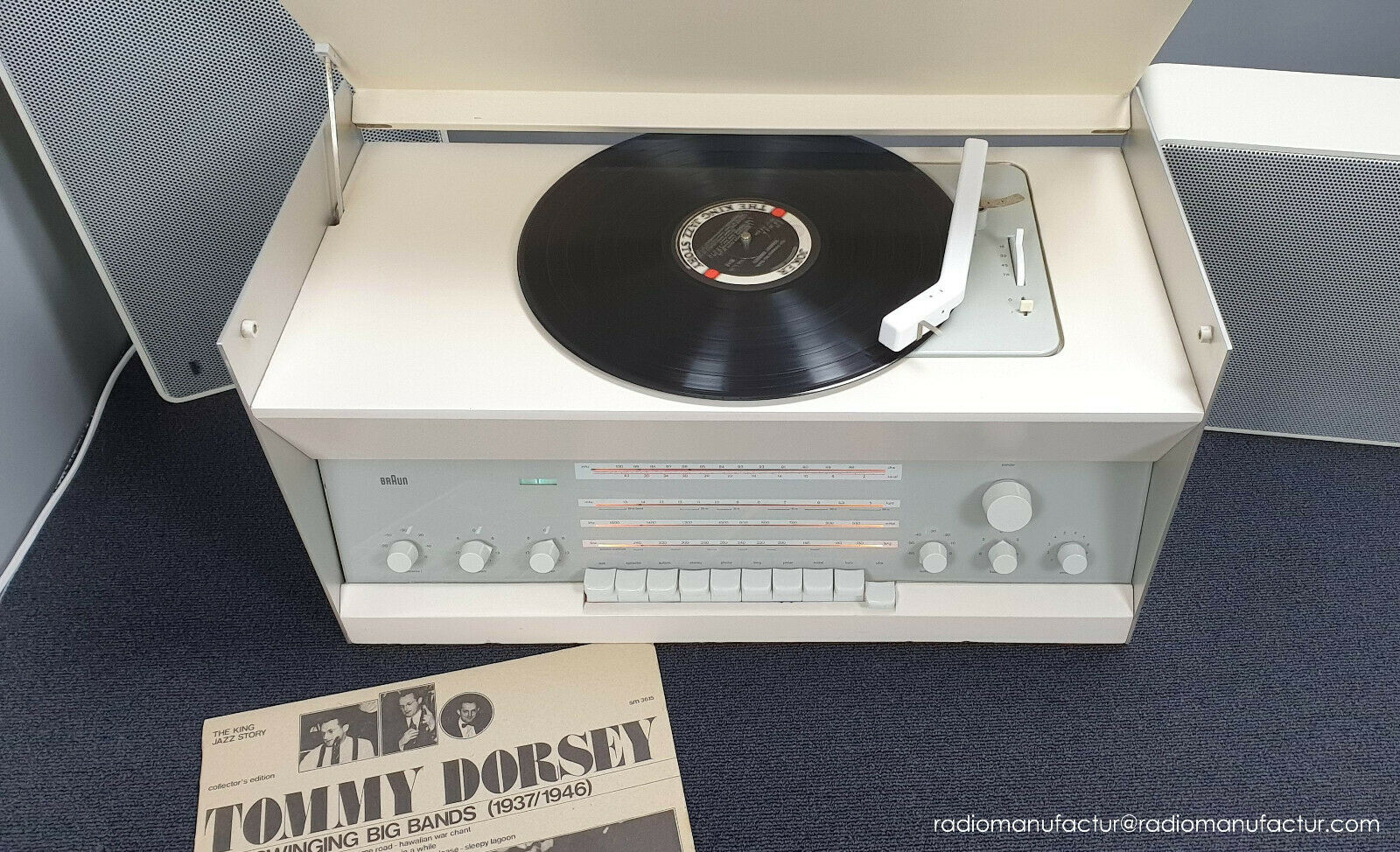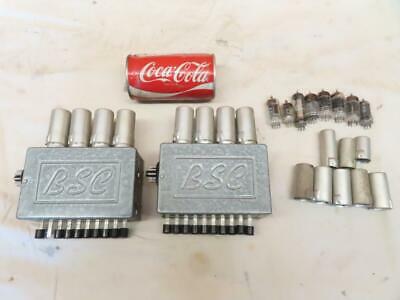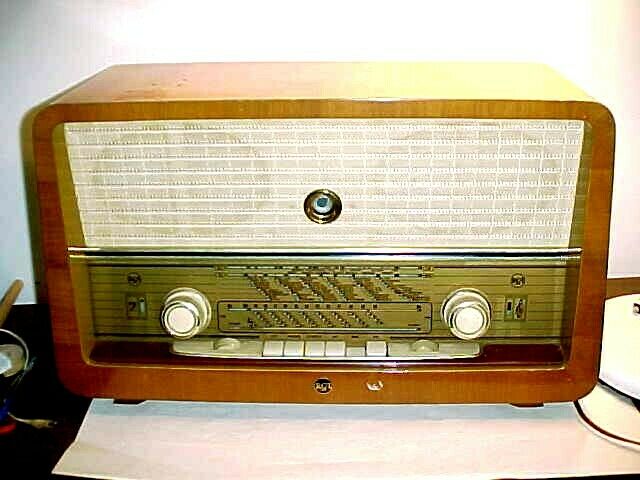-40%
Tube Radio BRAUN ATELIER 3 - SPEAKER L480/1 - TURNTABLE - Made in Germany - 1962
$ 1737.12
- Description
- Size Guide
Description
Welcome to the auction. I have carefully and professionally restored this beautiful model for you. From my collection I offer:BRAUN
Atelier 3
Turntable PC4
Model 1962 - 1963
2 Loudspeaker
s
L400
Circuit diagram in Copy
Braun Atelier 3 FM
Braun Atelier 3 Record Player
Braun Atelier 3 Shortwave
Braun Atelier 3 Broadcast
Braun Atelier 3 Longwave
The Braun Atelier 3 and the speakers Braun L480/1 have the typical design of Fritz Eichler and Artur Braun. The video and the pictures shows the current condition. The design with its clear lines was already trendsetting in the late fifties. Braun his time was far ahead. In Germany, the style of other radios was jokingly called "Gelsenkirchener Barock". Because the design was very modern, it was primarily bought by the avant-garde, for example, by doctors, lawyers, architects or higher officials. Many Braun models can be found in major museums around the world.
The Receiver Atelier 3 vividly realizes the term "vintage". After all, the design was developed over 60 years ago and is still very modern today. The Atelier 3 with the speakers
L480/1
in white polished varnish looks very elegant. Decorate your living room with a really classy and beautiful piece designed by the world famous Dieter Rams. Find a nice place in your living room for the receiver and speakers and enjoy the sound of this system. It will be a special eye-catcher and will delight you and your visitors.
Please note that this analog radio-turntable combination was made for Europe. You can see his age of over 50, it has minor scratches, changes in color and bumps. I restored the technology very carefully so that it can be used for many years to come.
For those interested in technology, some details about all components.
Receiver Atelier 3
Tubes 11: ECC85, ECH81, EF89, EBF89, EM84, ECC83, 2x EC92, 2x ELL80
Principle: Super-Heterodyne, 8 AM circuits 12 FM circuits
Wave bands: FM, Broadcast, Short Wave, Long Wave
Turntable: Braun PC4
Loudspeaker: 2x L400
Power: AC 110, 125, 150,
220, 240 Volt
Material: Wood, Bakelit
Dimensions: 23.3 x 11.9 x 11 inch, (566 x 301 x 280 mm)
Net weight: 15 kg / 33 lb 0.6 oz (33.04 lb)
Selling price Combination Atelier 3: 685.00 DM (German Mark)
Selling price 2x Speaker L480/1: 596.00 DM (German Mark)
More very interesting informations about the models can be found on the Internet at radiomuseum.org.
Some basic information about my offers.
I have carefully and functionally restored the Braun Atelier 3 and the speakers Braun L480/1. It is very important to me that the radio retains its character. It is old and should look old in the future as well, so I am restoring the cabinet very gently and as little as possible, so that the grown patina should be preserved. The Braun system works in quality, as shown in the YouTube videos and pictures. The radio has antennas that allow you to receive stations on FM and AM. However, good outdoor antennas offer better reception.
Although the restoration has been carried out very carefully, I would like to point out that, for example, when switching on a lamp, an electrical device or a smartphone pops or noises in the speaker can occur. These are typical noises that come from the environment and can not be claimed. Please note that the radio uses analogue technology, it was developed for the European market nearly 60 years ago. A comparison with today's digital technology is hardly possible. This radio is pure nostalgia and you will like it very much as it is.
Some important basic remarks on every restoration of a radio. Defective parts like tubes, resistors, rectifier, lamps and other parts have been replaced. Capacitors in old devices are always "time bombs". These components have enormous capacity changes due to their age and construction. If capacitors dry out or moisture penetrates them, the capacitance values change drastically, this can lead to irreparable short circuits in all modules.
For these reasons, I basically replace all these passive components in respective parts of the radio. When these components are replaced, most sources of error are eliminated. Due to the age, some components are no longer available. Therefore I point out that it is sometimes necessary to use parts from identical or similar models of the manufacturer during a restoration, and there is no reason for a complaint. This is necessary to ensure functionality and safety.
A few words about me. I enjoyed training in radio and television in a long-established company. My apprenticeship in craft began in 1967 when tube technology reached its peak. In 1977 I passed the master examination. Over the years I have professionally repaired several thousand devices. My offered radios have been in my collection for decades. Now comes the time when I have to close my collection. I hope that these wonderful radios and devices are in good hands. I am happy to answer your questions about tube radios. Please contact me via E-Mail.
An important note: The record is not part of the auction!
Due to the weight, the System is sent in two packages. One package with Atelier 3 and one with two speakers L480/1!
I will start packaging as soon as the payment has been received in my account. The sale can be canceled if the payment is not made within three days. My packaging meets the requirements of Deutsche Post / DHL. These photos show an example of how my packaging is made:
Braun, some interesting facts.
The company Max Braun oHG was founded in 1921 by the engineer Max Braun in Frankfurt. 1923 constructed Max Brown his first radio and produced for the expanding radio industry tube socket and accessories.
In 1926, Max Braun got his first own factory premises in Frankfurt am Main, where the accessories are made for radio. The great success encouraged him to move already two years later in a new factory building. There, the production of an amplifier for the sound of large events began. At the end of the decade, Brown took over the production of radio receivers in license by Carl Sevecke.
With the beginning of 1933 the development and production of self-developed radio began. These were the models Mozart, Edel-Super and Super W4, and the production of the Volksempfänger. The first predecessor of SK55 was music combination Phono-Super 637GW. At 1936, the first portable radios were designed and manufactured.
Due to the war years the company Braun had to take over the production of armaments. In 1944 the Frankfurt factories were destroyed by air raids. The production facilities were built after the war. In addition to other equipment there began the production of the first dry shaver Model 50S.
After the sudden death of Max Braun 1951 (he was only 61 years old) took his sons Artur and Erwin Braun company. Erwin Braun formed the appearance of the company completely around. He changed the face in the company and unified the product range.
A fundamentally new was the thought to establish a department for design. Here new products should be developed, which should be distinguished by a different appearance from the crowd of other manufacturers. It emerged in teamwork most products and designs. Very farsighted was also collaborating with the School of Design in Ulm, Germany, here the foundations were laid for the world-famous Braun design. Important names for product design were beside Fritz Eichler, also Hans Gugelot, Wilhelm Wagenfeld, Herbert Hirche and Dieter Rams. Early pioneering products in the radio range are the small tube radio SK 1 and the radio-phonograph combination series "PK-G". Reactions to the straightforward style, which was characterized by its clear forms, could not be greater.
Some loved the Braun design, others despised him. It was especially the elite who was enthusiastic about the design and was in accordance with purchasing power. Only gradually copied some manufacturers the design, it was the so-called Nordic style in the sixties. The last Braun appliances with the model name Atelier was delivered in the year 1990.




















